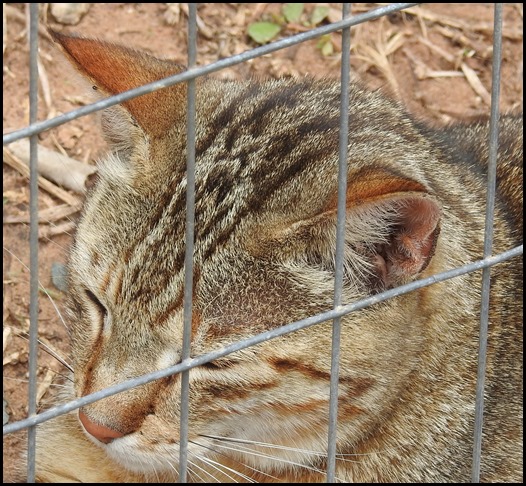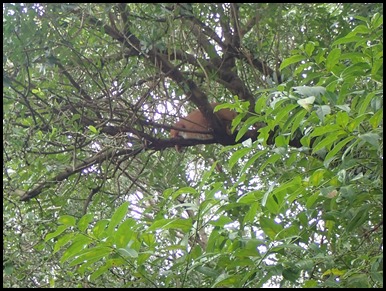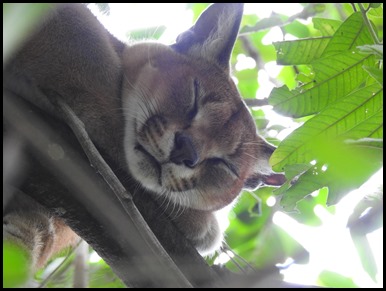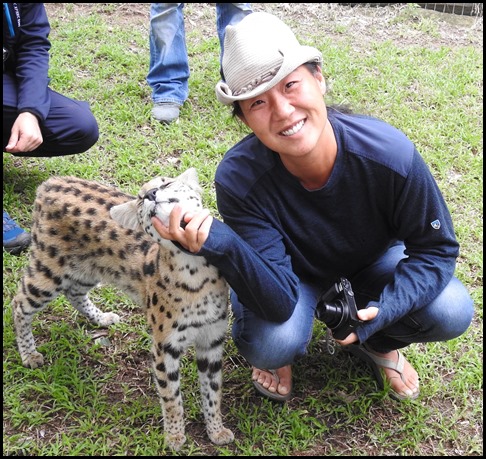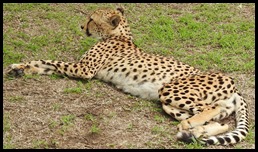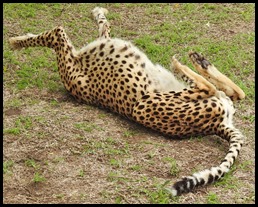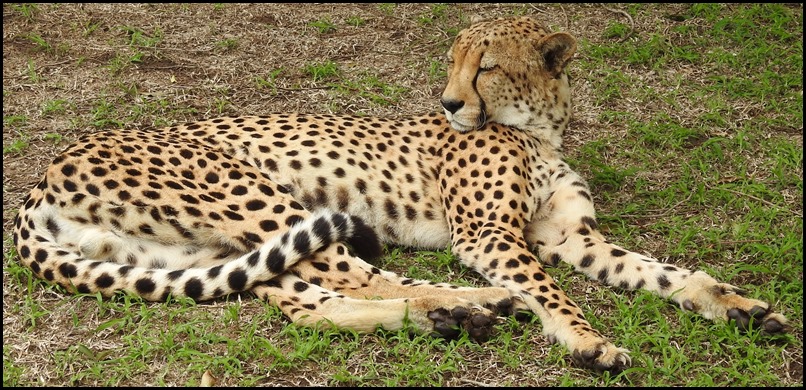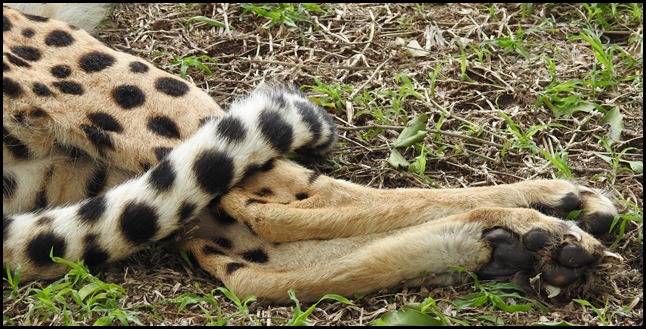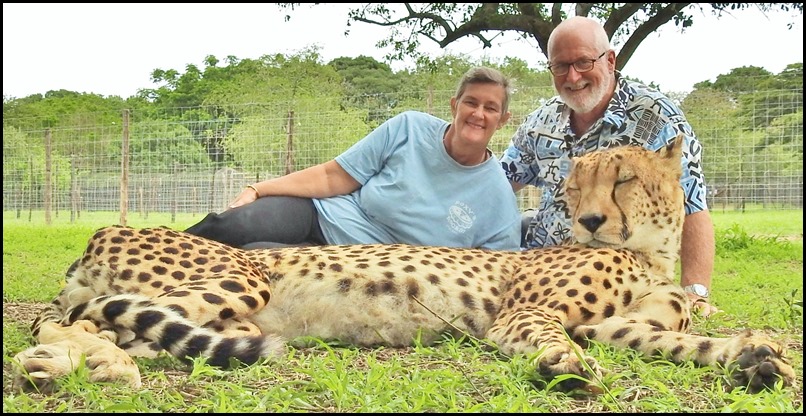Cheetah Project, Hluhluwe

|
Cheetah Project, Hluhluwe
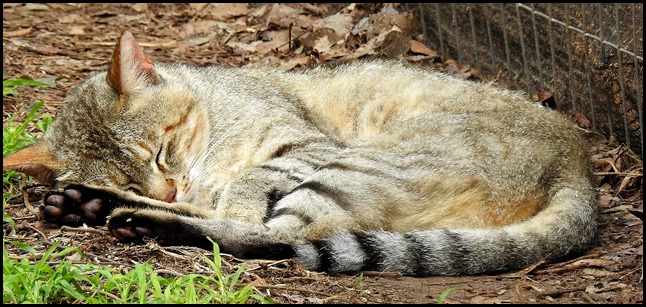 We arrived for the morning tour at
the Cheetah Project, Hluhluwe (still cannot get over the pronunciation –
Shoosh-louie) and soon our guide Wonder was introducing us to our first South African Wild Cat.
Six thousand years ago Egyptians domesticated the African Wild Cat to control mice and rats raiding granaries. From these tamed animals, the domestic cat was bred. Although it is an agile tree climber, this cat spends most of its time on the ground. Male and female both measure ninety centimetres but the male is heavier coming in at 3,8 to 6,4 kilograms compared to the females 2.6 to 5.5. The breeding season is all-year round and two to five babies are born after a two-month pregnancy but the main season is between July and January with most babies born between September and March. Their diet mainly consists of mice and rats but they are known to take birds, insects, hare, rabbit and on occasion baby antelopes. African Wildcat are nocturnal in the warm weather and diurnal during very cold weather. Wild cats are preyed upon as young cats by larger predators, such as foxes, wolves, other cats, and large birds of prey, such as owls, eagles and hawks. African Wildcat are fierce when threatened and can protect themselves from animals larger than themselves. The project here has released seven wild cats back into the wild or to game parks.
I could not get over the fact that although much bigger, this cat looked so much like my only puss, Timmy way back in 1965. .
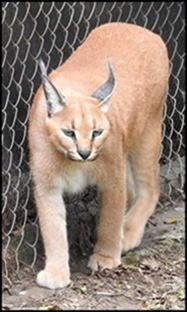 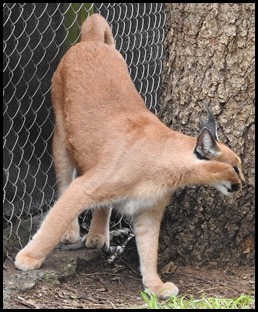  Next door was a pregnant lady. We moved on to visit her husband in his
pen.
 This mostly nocturnal creature, the Caracal is the largest African lesser cat measuring between 109 to 117 centimetres and weighs in at between 11 (female) and 18 kilograms. It can launch from sitting four to five metres into the air to catch a bird. Strong and fast enough to take down anything up to a reedbuck in size and is an exceptional climber. Slender build with long legs and a short, sharply tapered tail. The Caracal resembles a cross between a leopard and a lynx. Its coat is reddish-brown with distinctive tufted ears and white markings around its eyes and on its throat, chin and belly. No set breeding season the ‘laydees’ can set their cap at three different males (lucky so-and-sos) and one to six kits are born after about seventy-eight days, often independent from the age of one, reaching adulthood after sixteen months. The Egyptians had bronze figurines of caracals to guard the tombs of pharaohs.
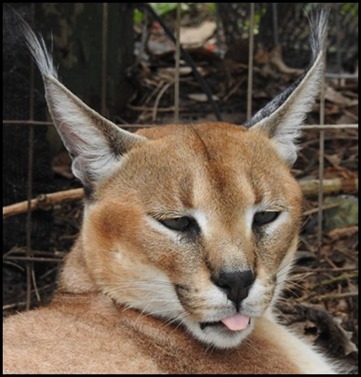 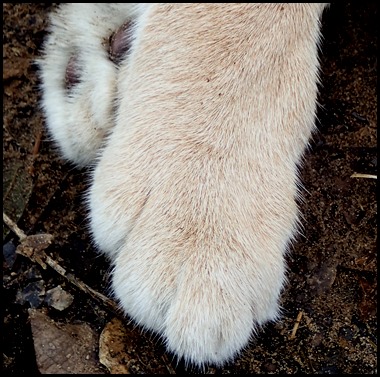 A gorgeous
boy with handsome feet.
The Caracal derives its name from the Turkish word ‘karakula’ which means black ear. The back of the ears are indeed black with marvelous tufts. The saying “to put the cat amongst the pigeons” comes from the old Middle Eastern sport where a Caracal was turned out in an arena as a flock of pigeons was released. Bets were placed on how many birds the creature could take down. Although not endangered in any way, they are very unpopular with stockmen as they kill for fun, easily killing up to fifteen sheep in one night. Needless to say, they risk the wrath of the farmers at the end of a gun…. twelve have been released from the Project thus far.
Also in the pen was our chaps
non-pregnant, ‘other wife’ who was soundo up in a tree.
 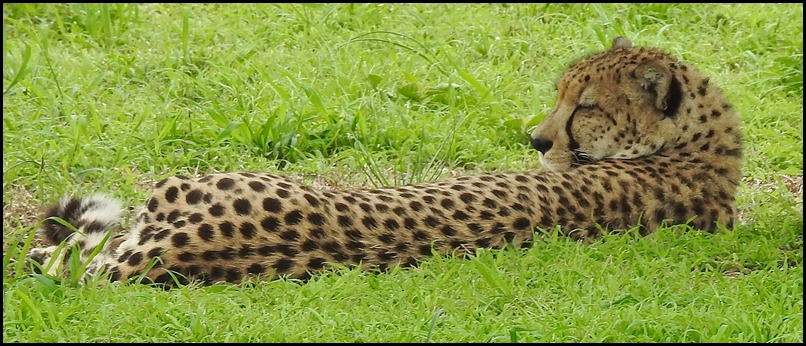 As we stepped into our next enclosure we caught sight of ‘the main
event’ a cheetah called Dusk.
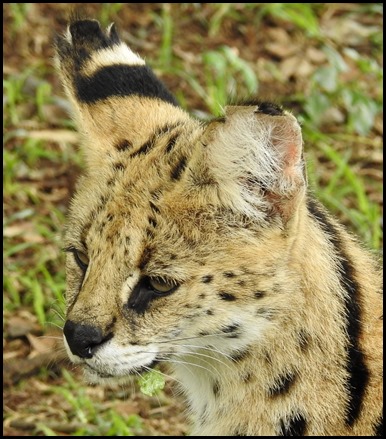  Meanwhile, we met a gorgeous little lady sadly mourning the loss of her
kitten during a recent, terrible storm.
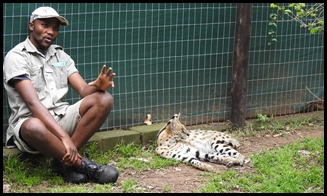  She bimbled over and plomped down next to Wonder who showed us where to sit to
pet her.
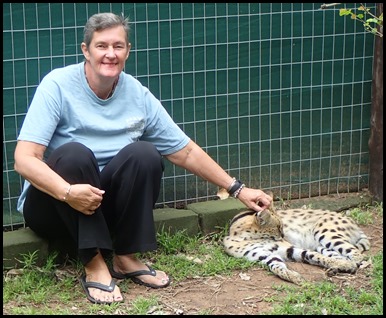 Such soft
fur.
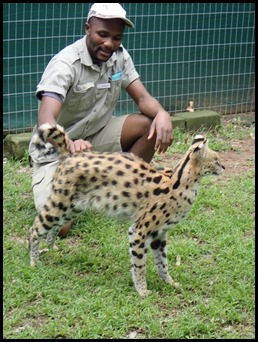 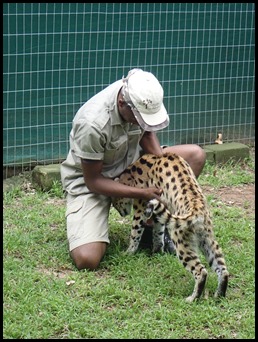 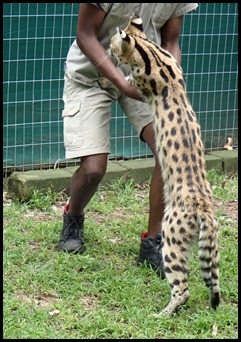 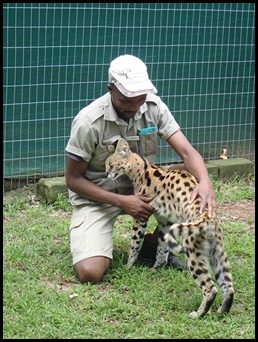 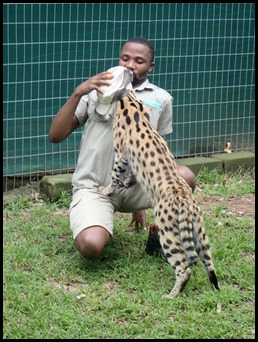 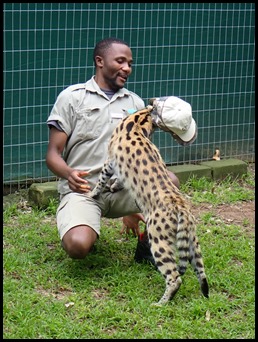 Wonder told us us about servals and showed the deep bond and real affection these two have.
The Serval is much larger than the domestic cat. It is long legged, the hind legs longer than the front legs. Its neck is long and its head is small, with large, very erect ears. The serval’s coat is yellowish-tan, with black spots, bands and stripes. The tail is ringed with black, and the under parts of the body are white or light tan. This 110-centimetre cat weighs in at between eight and a half to thirteen and a half kilograms. Litters of three to four, are born in thick grass cover or underbrush. The gestation period is 68-72 days. Births often occur at the end of summer. They are born in a lair, however, to protect them, mum will move her offspring frequently to new hiding places. Rodents especially viel rats along with birds, frogs, insects, small reptiles and even fish make up this pretty cat’s diet. Seventeen servals have been released from the Project.
A very purring shine to Kimi.
.......he closed
his eyes as if quite bored.
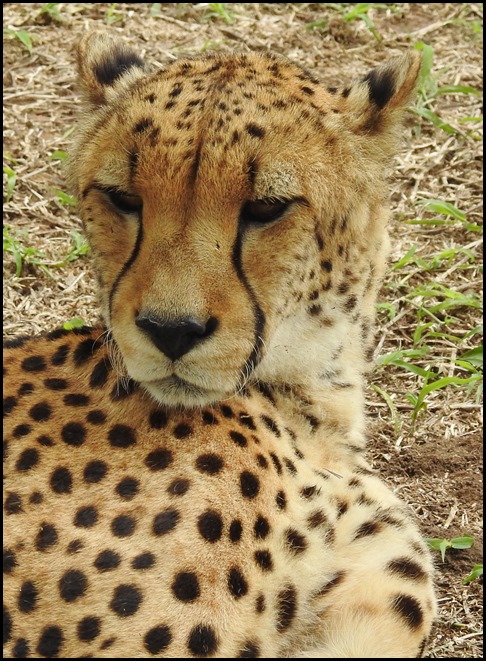 Sharp as a
razor though when he heard zebra in a distant field.
 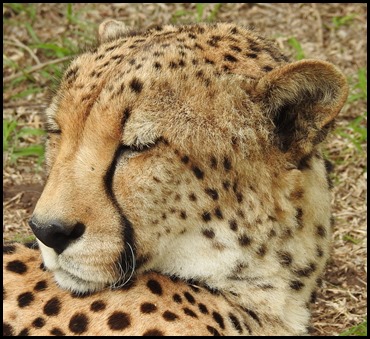 The cheetah (Vulnerable Status) is the most unique and specialised member of the cat family. The world’s fastest land animal reaching speeds of sixty-eight to seventy-five miles per hour (naught to sixty in three seconds). Unlike other cats, the cheetah has a leaner body, longer legs and is referred to as the “greyhound” of cats. Length seventy to ninety centimetres and weighing in at between twenty-one and seventy-two kilograms. It is not an aggressive animal, preferring flight over fight, there is no record ever of an attack on a human. They cannot roar but growl, spit like a cat and purr loudly. They have nearly two thousand black spots on their short coat.
A cheetah will typically start a hunt sixty to a hundred metres from the intended target such as an antelope and within seconds, will be racing at full tilt. If the creature is alerted in time, it will attempt to throw the cheetah off its trail by zigzagging and dodging between trees and shrubs. Using its long, heavy tail like a stabiliser, the cheetah can turn at ninety degrees without affecting the speed of the chase. They have loose shoulders and only one foot is on the ground giving a gliding motion. The jaw clamp around the victims’ throat is not as powerful as other big cats so the kill may take five to twenty-five minutes. This gives the cheetah the chance to regulate heart beat and breathing but the risk then is that hyena or other predators will come in and steal away the meal. The cheetah needs half an hour before it can eat, usually at the kill sight. Adult males are social creatures but the female is solitary. She can come into season at whim and carries her babies for nearly three months giving birth to two or three cubs (rare instances of up to seven or eight). Weaned at six months the cubs will stay with mum for quite some time The Project has released four cheetahs to other game reserves. Many males are infertile so four is actually a big success, there are only just over seven thousand cheetahs in the wild.
A real joy for us to have the
opportunity to pose behind Dusk.
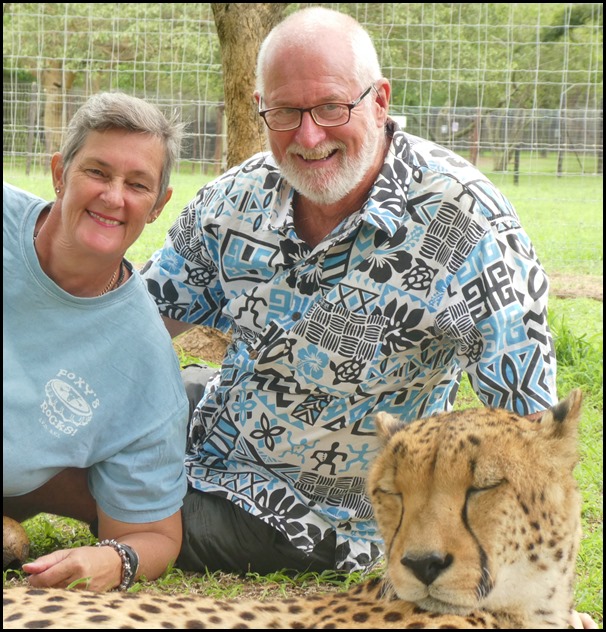 ALL IN ALL AN UNFORGETTABLE
EXPERIENCE
AMAZINGLY CLOSE AND
PERSONAL |
